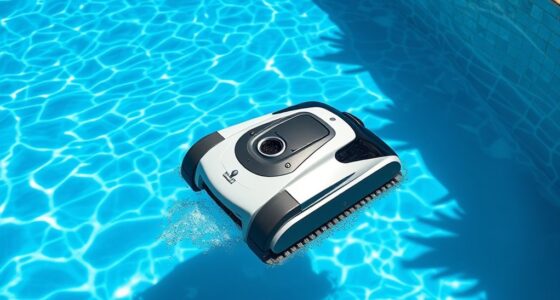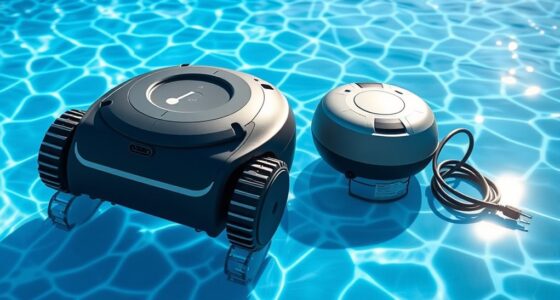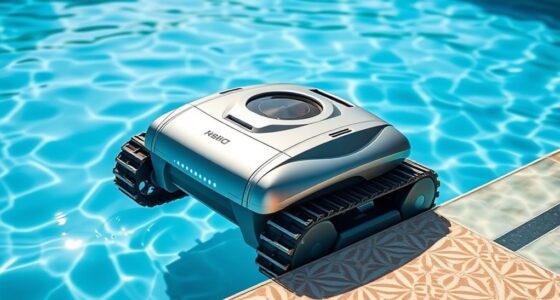Automatic pool cleaners are great for removing surface debris and keeping your pool tidy, but they can’t fully handle heavy algae buildup or cloudy water. They mainly scrub surfaces and circulate water, so thick algae and deep cloudiness often require manual scrubbing, chemical treatments, and proper water chemistry. While they help maintain cleanliness, addressing stubborn algae and cloudiness calls for additional care—continue to see how you can keep your pool crystal clear.
Key Takeaways
- Automatic pool cleaners effectively remove dirt, debris, and some algae but struggle with heavy algae buildup.
- They improve water circulation, helping reduce cloudiness but cannot fully address severe algae or chemical imbalances.
- Heavy algae and thick debris can clog filters and hinder cleaner movement, limiting their effectiveness.
- Proper water chemistry, manual cleaning, and chemical treatments are necessary supplements for cloudy or algae-infested pools.
- Regular maintenance and combined cleaning methods ensure clearer, healthier pool water beyond automatic cleaner capabilities.
How Automatic Pool Cleaners Work in General

Automatic pool cleaners work by moving around your pool’s surface and floor to pick up dirt, debris, and algae without your manual effort. They navigate the pool using electric motors, brushes, or suction to efficiently clean different surfaces. This automation helps maintain pool safety by reducing the chance of slipping on debris or algae buildup. When choosing a cleaner, consider equipment durability—look for sturdy parts and reliable motors that withstand regular use and exposure to chemicals. These cleaners operate on various power sources, including cords or batteries, ensuring continuous cleaning with minimal oversight. By automating the cleaning process, they help you keep your pool safe, clean, and inviting, saving you time and effort while protecting your investment in quality equipment. Additionally, reliable cleaning performance is essential for effectively managing algae and cloudy pools, ensuring your pool stays crystal clear and safe for swimming. Proper maintenance and understanding of how these devices work can further enhance their ability to handle algae and cloudy pools, making your pool care routine more efficient.
Effectiveness Against Algae Buildup

While automatic pool cleaners are effective at removing dirt and debris, their ability to combat stubborn algae buildup varies depending on the model and features. Some models, especially those with strong water filtration systems, can help reduce algae by circulating and filtering water more efficiently. Proper water circulation is crucial to prevent algae from taking hold in the first place. Additionally, using algaecide treatments regularly can significantly diminish the chances of algae growth. Regular pool maintenance including brushing and chemical balancing is also essential for preventing algae. However, if your pool has a pool cover that traps heat and organic matter, algae can thrive beneath it, making cleanup harder for your cleaner. In such cases, manual scrubbing and chemical treatments are often necessary to fully eliminate algae. Automatic cleaners alone may not be enough to prevent algae growth if water filtration isn’t ideal or if debris gets trapped under pool covers. Combining regular maintenance, proper filtration, and algae-specific treatments will give you the best results.
Managing Cloudy Water With Robotic Cleaners

Cloudy water can be frustrating, but robotic cleaners can help improve water clarity by removing debris and circulating water effectively. They work well alongside pool cover options, reducing debris accumulation and limiting sunlight exposure that fuels algae growth. Using a robotic cleaner regularly keeps the pool free of dirt, algae spores, and other particles that cloud the water. Additionally, robotic cleaners enhance circulation, which helps distribute chemicals evenly and prevents stagnation. Proper chemical balance and filtration are essential components of maintaining clear water, alongside robotic cleaning. If you use solar heating, maintaining clear water is essential for efficiency; debris can block collectors and reduce heat transfer. Proper chemical balance, filtration, and water treatment methods further support water clarity. Combining robotic cleaning with proper pool cover options and monitoring your solar heating system ensures your pool stays clean, inviting, and crystal clear with less effort.
Limitations of Automatic Cleaners for Heavy Contamination
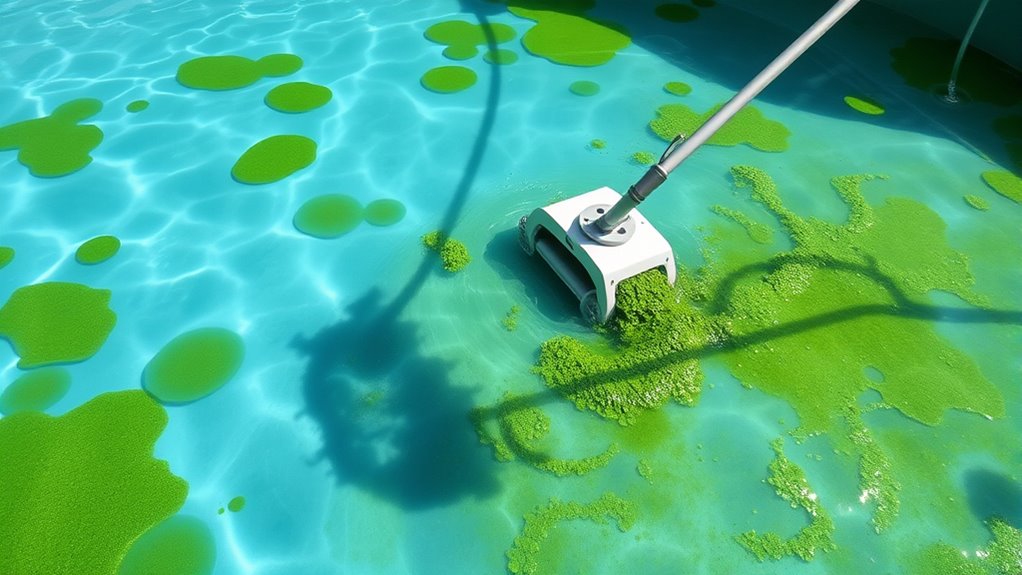
Automatic cleaners can struggle with heavy algae buildup and thick debris, making them less effective. When contamination is severe, you might find yourself needing additional manual cleaning or chemical treatments. Cloudy water caused by heavy contamination can also hinder the cleaner’s ability to function properly. Additionally, good lighting in the pool area can be essential for spotting and addressing problem areas that automatic cleaners may miss. Proper filtration systems can help prevent some of these issues by reducing debris before the cleaner does its work.
Heavy Algae Challenges
Heavy algae buildup can overwhelm automatic pool cleaners, making it difficult for them to effectively remove all contaminants. When algae cover the surfaces, debris becomes thick and sticky, clogging filters and impeding movement. Pool accessories like brushes and vacuums can assist in manual cleaning, but automatic cleaners often struggle with this level of contamination. Additionally, improper chemical balancing allows algae to thrive, creating a stubborn layer that’s tough for robotic cleaners to handle alone. You may find that your cleaner gets stuck or leaves patches behind, especially if algae are dense and embedded in the pool’s corners. To improve results, it’s essential to first treat the algae with appropriate algaecides and ensure your pool’s chemical levels are properly balanced before relying solely on your automatic cleaner. Proper chemical balancing and the use of specialized algaecides can significantly enhance the effectiveness of your cleaning efforts. Incorporating somatic therapy techniques such as mindfulness and movement can also promote a calmer, more focused approach to pool maintenance. Understanding the limitations of automatic cleaners can help set realistic expectations and guide you in combining manual and robotic cleaning methods effectively. Recognizing the impact of algae on filtration systems can further prevent clogging and maintain pool clarity. Regularly inspecting and maintaining your pool’s filtration system can prevent issues before they become severe, improving overall cleaning efficiency.
Cloudy Water Limitations
Have you noticed that your pool water remains murky despite running your automatic cleaner? Heavy contamination often exceeds what these devices can handle. Automatic cleaners mainly scrub the pool surface but don’t address chemical balance or deep filtration. When water is cloudy, it’s usually due to unbalanced chemicals or particles that settle below the surface. These cleaners struggle with heavy debris or algae buildup, leaving water cloudy. To improve clarity, you need to maintain proper chemical balance and perform manual cleaning when necessary. Here’s a quick overview:
| Issue | Cause | Solution |
|---|---|---|
| Cloudy water | Heavy contamination | Manual cleaning & chemical balance |
| Surface debris | Large debris on pool surface | Automatic cleaner helps |
| Chemical imbalance | pH, chlorine off | Test and adjust chemicals |
| Deep particles | Settled below surface | Manual vacuuming |
| Filter overload | Excess debris | Clean filters regularly |
Additional Treatments to Complement Automatic Cleaning
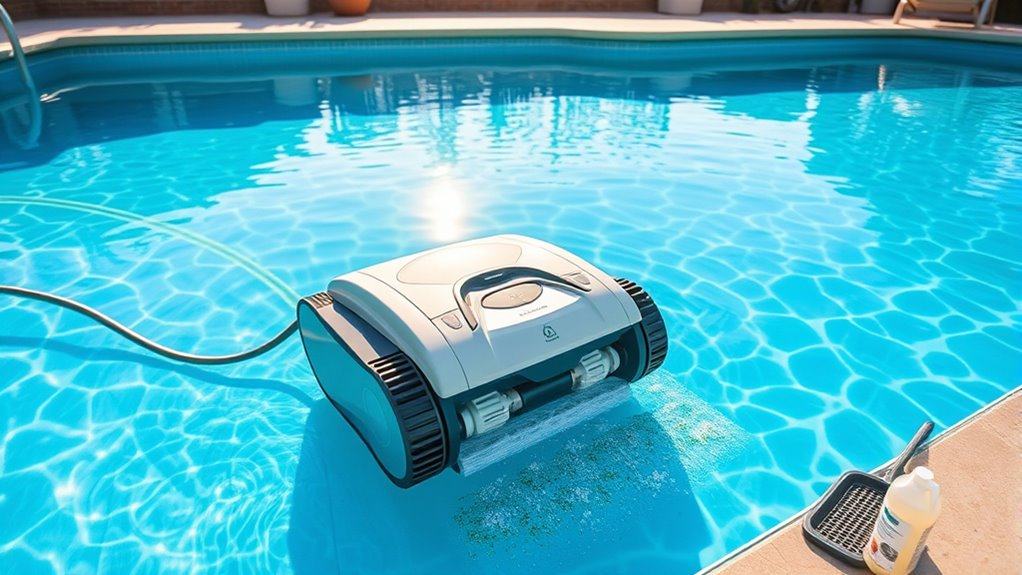
To keep your pool crystal clear, you need more than just an automatic cleaner. Using effective algaecides, maintaining proper water chemistry, and performing regular upkeep are essential. These treatments work together to guarantee your pool stays clean and inviting year-round. Proper water chemistry, including pH and sanitizer levels, plays a crucial role in preventing algae growth and cloudiness, making it an important water chemistry factor to monitor regularly. Ensuring your filtration system is functioning correctly is also vital for consistent water quality and overall pool health. Additionally, recent AI discoveries suggest that advanced monitoring systems could soon automate these processes further, enhancing pool maintenance efficiency. Regular testing and adjusting of water parameters are necessary to sustain an optimal environment and prevent issues like stagnant water or bacterial buildup.
Effective Algaecide Use
Wondering how to keep algae at bay even with an automatic pool cleaner? Using an effective algaecide is your best bet. It works alongside your cleaner to prevent algae growth and keep your water clear. To maximize results, ensure your pool heater runs efficiently, as warm water encourages algae growth. Regular pool cover maintenance also helps by reducing debris and limiting algae spores from entering. Here’s a quick look at how algaecides fit into your routine:
| Action | Benefit |
|---|---|
| Apply algaecide weekly | Prevents algae from forming |
| Maintain pool cover | Keeps debris and spores out |
| Check heater efficiency | Keeps water temperature *ideal* |
| Regular cleaning | Complements algaecide and manual efforts |
Additionally, understanding financial management can help pool owners allocate resources wisely for maintenance and upgrades. Proper water chemistry management is also crucial for preventing algae and maintaining water clarity.
Proper Water Chemistry
Maintaining proper water chemistry is vital for optimizing your automatic pool cleaner’s performance and keeping your water clear and safe. Regular pool filter maintenance ensures debris is effectively removed, preventing clogs that hinder cleaning. Chemical balancing is essential; test your water frequently to keep pH levels between 7.2 and 7.6, and maintain proper chlorine levels to prevent algae growth. When chemicals are correctly balanced, your pool cleaner works more efficiently, reaching every corner without resistance. Proper water chemistry also reduces the strain on your filtration system, extending its lifespan. Keep a close eye on your water’s chemistry, and adjust treatments as needed to create an environment where your automatic cleaner can do its best work, keeping your pool pristine and inviting. Additionally, understanding water chemistry can help you identify early signs of imbalance, preventing algae and cloudiness before they become major issues. Regular testing kits and chemical adjustments are key tools in maintaining this balance effectively. Being aware of prophetic dreams and their meanings can also serve as a helpful reminder to stay attentive to subtle signals in your environment, including your pool’s condition.
Regular Pool Maintenance
Regular pool maintenance involves more than just running your automatic cleaner; it requires additional treatments to keep your pool pristine and balanced. To prevent algae growth and cloudy water, consider using the right pool cover options to reduce debris and evaporation. Solar heating advantages can help maintain water temperature efficiently, minimizing chemical use and algae development. Regularly test and adjust your water chemistry, especially pH and sanitizer levels, to support your cleaning efforts. You might also need to shock your pool periodically or add algaecides for extra protection. These treatments, combined with your automatic cleaner, ensure your pool stays clear and inviting. Staying proactive with maintenance helps extend equipment life and reduces long-term costs, making your swimming experience more enjoyable.
Tips for Maintaining a Clear, Algae-Free Pool

To keep your pool crystal clear and free of algae, consistent maintenance is essential. Regularly check and adjust your chemical levels, especially chlorine, to prevent algae growth. Skim the surface daily and vacuum the bottom weekly to remove debris and prevent buildup. Maintain proper filtration by cleaning the filter regularly, which supports pool safety and prolongs equipment longevity. Run your automatic pool cleaner frequently to reduce manual effort and ensure thorough cleaning. Keep an eye on pH levels; balanced water helps prevent algae and keeps your pool inviting. By staying diligent, you’ll reduce the risk of algae, enhance pool safety, and extend the lifespan of your equipment. Consistent care makes your pool easier to manage and ensures it stays sparkling clear.
Frequently Asked Questions
Can Automatic Pool Cleaners Prevent Algae Growth Entirely?
Automatic pool cleaners can’t prevent algae growth entirely, but they help maintain cleaner pools by removing debris and algae spores. For effective algae prevention, you still need proper chemical dependency, like regular chlorine or algaecide treatments. Using your cleaner regularly supports your chemical efforts, reducing algae buildup. Remember, combining mechanical cleaning with proper chemical balance is essential for keeping your pool clear and algae-free.
Do Robotic Cleaners Require Extra Chemical Treatments for Algae?
Think of robotic cleaners as your pool’s diligent gardener, but they don’t do all the work alone. While they sweep and scrub, you still need to manage chemical dependency for algae prevention. Extra chemical treatments aren’t always necessary unless algae has already taken hold. Regular chemical balance keeps your pool clear and reduces algae growth, so your robotic cleaner can focus on its job—making your pool sparkle without relying solely on it for algae control.
How Often Should I Run My Automatic Cleaner for Cloudy Water?
You should run your automatic cleaner at least twice a week to keep your pool clear. Regular cleaner frequency helps prevent debris buildup and supports filter maintenance. For cloudy water, increase the cleaner’s run time and make sure your filter is clean and functioning properly. This combination helps improve water clarity and reduces algae growth, making your pool inviting and safe for swimming.
Are Automatic Cleaners Effective in Pools With Heavy Algae Infestation?
Think of your pool as a garden needing careful tending. Automatic cleaners can help with algae control and removing debris, but they’re not magic wands for heavy algae infestations. They work best when your chemical balance is on point. For severe algae, you’ll still need to shock the pool and balance chemicals first. An automatic cleaner supports your efforts, but it can’t do all the heavy lifting alone.
Can Automatic Pool Cleaners Replace Chemical Sanitation?
Automatic pool cleaners can’t substitute chemical sanitation because maintaining proper chemical balance is essential for clean, safe water. While they help with debris removal and reduce manual effort, you still need to follow regular maintenance routines, including shocking the pool and checking pH levels. Relying solely on cleaners risks algae growth and cloudy water, so combining them with proper chemicals ensures a healthy, clear pool.
Conclusion
While automatic pool cleaners are like trusty sidekicks in your pool’s maintenance, they’re not magic bullets for heavy algae or stubborn cloudiness. Think of them as the first line of defense, working alongside chlorine and chemical treatments. To keep your pool crystal clear and algae-free, maintain regular cleaning, monitor water chemistry, and don’t hesitate to seek expert advice when needed. With the right combo, your pool will shine brighter than a summer sun.


